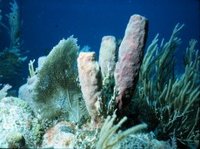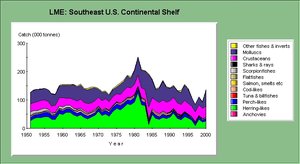Southeast U.S. Continental Shelf large marine ecosystem
Contents
Introduction Map of the Southeast US Continental Shelf. (Source: NOAA (Southeast U.S. Continental Shelf large marine ecosystem) )
This Large Marine Ecosystem (LME) is characterized by its temperate climate. It borders the Atlantic Ocean, extending from the Straits of Florida to Cape Hatteras, North Carolina. It contains many bays and sounds, and extensive coastal marshes that provide unique habitats for living marine resources. LME book chapters and articles pertaining to this LME include Yoder, 1991.
Productivity
Upwelling along the Gulf Stream front and intrusions from the Gulf Stream cause short-lived plankton blooms. The offshore upwelling regime is not as intense as in the higher latitude regions (see Yoder 1991, and NOAA, 2002). The Southeast US Continental Shelf LME is considered a Class II, moderately productive (150-300 gC/m2-yr) ecosystem based on SeaWiFS global primary productivity estimates. Additional information is provided by NOAA statistics in Our Living Oceans, 1999, and a chapter on Marine Resources , in Status and Trends of the Nation's Biological Resources.
Fish and Fisheries
 Southeast US Continental Shelf Marine Life. (Source: NOAA)
Southeast US Continental Shelf Marine Life. (Source: NOAA) The LME is distinguished by a very high percentage of commercially important crustacean catches. The valuable coastal shrimp fishery (brown, white, pink and red shrimp species) accounts for 10% of the total tonnage landed from the South Atlantic region. A second important fisheries group is clupeoids (herrings, sardines and anchovies). The Food and Agriculture Organization (FAO) 10-year trend (1990-1999) for this LME shows a major fluctuation in catch, with a 1994 peak of almost 200,000 tons (see FAO, 2003, figure 18). The capture was about 100,000 tons in 1990, and 60,000 tons in 1999. Our Living Oceans (see NOAA, 1999, p. 215) has specific landings of blue crab, sea urchin and oyster from the Atlantic coast. It also includes landings and spawning biomass of menhaden, from 1950 to 1997, p. 141. The South Atlantic Fishery Management Council has regulatory control over this LME. Coastal pelagic fishes are jointly managed under the Coastal Migratory Pelagic Resources Fishery Management Plan and the regulations adopted by the South Atlantic fishery management council. Check appendix 2 of NOAA, Our Living Oceans, 1999 for specific fishery management plans.
Pollution and Ecosystem Health
 Our colleagues at the University of British Columbia Fisheries Center have detailed fish catch statistics for this LME, as does the UN Food and Agriculture Organization. (Source: NOAA)
Our colleagues at the University of British Columbia Fisheries Center have detailed fish catch statistics for this LME, as does the UN Food and Agriculture Organization. (Source: NOAA) The EPA’s Southeast region coincides with the boundaries of the Southeast US Continental shelf Large Marine Ecosystem (see EPA, 2001, for the coastal condition of the Southeast). For this LME as a whole, dissolved oxygen and fish tissue are good, and water clarity, coastal wetlands, eutrophic condition, sediment and benthos are fair (see EPA’s 7 primary indicators for this LME in EPA, 2001). The condition of southeastern estuaries is fair. Approximately 54% of estuarine areas are in good ecological condition (EPA, 2001). Species, such as shrimp, crabs and menhaden, which account for much of the harvest of this LME, are estuarine-dependent. For figures for coastal wetland habitat loss from 1780 to 1980, see EPA, 2001, p. 91. 40% of all wetlands existing in 1780 had disappeared in 1980. Another primary problem is sediment contamination by pesticides and metals. Municipal wastewater treatment plants and pesticides applied to agricultural lands are sources of coastal pollution. This LME is in the best condition of all 4 continental LMEs for the USA. EPA’s EMAP Program provides data on environmental stressors (water quality, sediment quality and tissue bioaccumulation). NOAA’s National Status and Trends program provides data on toxic contaminants and their ecological effects.
Socioeconomics
 (Source: NOAA)
(Source: NOAA) The 7 EPA indicators provide information about the characteristics of coastal waters that are valued by society. This information is relevant for the human uses of estuaries. The population (Population growth rate) of the [[coastal] areas] bordering this LME increased by 64% from 1970 to 1990 (U.S. Bureau of the Census, 1996). This increase in population pressures will require additional programs and increasing environmental awareness in order to correct existing problems of ecosystem health.
Governance
The South Atlantic Fishery Management Council manages fish stocks in this LME in collaboration with the NMFS Southeast Fisheries Science Center. Coastal pelagic fishes are jointly managed under the Coastal Migratory Pelagic Resources Fishery Management Plan and the regulations adopted by the South Atlantic Fishery Management Council. Check appendix 2 of NOAA, Our Living Oceans, 1999, for specific fishery (Fisheries and aquaculture) management plans. There is a fishery management plan for the shrimp fishery. There is increasing need for effective management of these resources given the predicted influx of people (EPA, 2001).
References
- Alexander, and B.D. Gold, eds. Food Chains, Yields, Models, and Management of Large Marine Ecosystems. AAAS Symposium. Westview Press, Inc., Boulder, CO. 49-66. ISBN: 0813383862.
- EPA, 2001. National Coastal Condition Report. Chapter 4.
- FAO, 2003. Trends in oceanic captures and clustering of large marine ecosystems—2 studies based on the FAO capture database. FAO fisheries technical paper 435. 71 pages.
- Hyland, JL, TJ Herrlinger, TR Snoots, AH Ringwood, RF Van Dolah, CT Hackney, GA Nelson, JS Rosen and SA Kokkinakis, 1996. Environmental quality of estuaries of the Carolinian Provence: 1994. NOAA Techn. Memo. NOS ORCA 97. Silver Spring, MD.
- Marine Resources, in "Status and Trends of the Nation's Biological Resources", an electronic document published by USGS.
- NMFS, 1999. Our Living Oceans (OLO)- Report on the Status of US Living Marine Resources. 1999. U.S. Dept of Commerce, NOAA Tech. Memo. NMFS-F/SPO-41, 301p
- A National Atlas: Health and use of coastal waters, United States of America; Fishery resource assessment programs. 1988. Folio Map No. 7,Office of Oceanography and Marine Assessment, NOS/NOAA, U.S. Dept. of Commerce.
- NOAA (National oceanic and Atmospheric Administration), 2002. Large Marine Ecosystems of the World.
- Southeast Fisheries Science Center. 1995. Status of fishery resources off the southeastern United States for 1993. National Oceanic and Atmospheric Administration Technical Memorandum NMFS-SEFC.
- Yoder, James A. 1991. Warm-temperate food chains of the southeast shelf ecosystem. In K. Sherman, L.M.
| Disclaimer: This article is taken wholly from, or contains information that was originally published by, the National Oceanic and Atmospheric Administration (NOAA). Topic editors and authors for the Encyclopedia of Earth may have edited its content or added new information. The use of information from the National Oceanic and Atmospheric Administration (NOAA) should not be construed as support for or endorsement by that organization for any new information added by EoE personnel, or for any editing of the original content. |